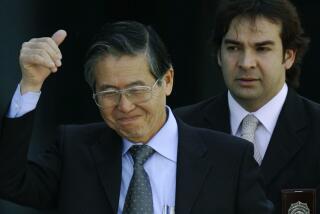Abimael Guzmán, head of Shining Path insurgency, dies, Peru’s government says

LIMA, Peru — Abimael Guzmán, the leader of the brutal Shining Path insurgency in Peru who was captured in 1992, died Saturday in a military hospital after an illness, the Peruvian government said.
Guzmán, 86, died at 6:40 a.m. after suffering from an infection, Justice Minister Aníbal Torres said.
Guzmán, a former philosophy professor, launched an insurgency against the state in 1980 and presided over numerous car bombings and assassinations in the years that followed. Tens of thousands died. Guzmán was captured in 1992 and sentenced in life in prison for terrorism and other crimes.
Guzmán preached a messianic vision of a classless Maoist utopia based on pure communism, considering himself the “Fourth Sword of Marxism” after Karl Marx, Vladimir Ilyich Lenin and Mao Zedong.
He advocated a peasant revolution in which rebels would first gain control of the countryside and then advance to the cities.
Look through the post 9/11 archives of our staff photojournalists and read the stories behind each sliver of history
Guzmán’s movement declared armed struggle on the eve of Peru’s presidential elections in May 1980, the first democratic vote after 12 years of military rule.
Throughout the 1980s, the man known to his followers as Presidente Gonzalo built up an organization that grew to 10,000 armed fighters before his capture inside a Lima safehouse in September 1992.
By the time Guzmán called for peace talks a year after his arrest, guerrilla violence had claimed tens of thousands of lives in Peru, displaced at least 600,000 people and caused an estimated $22 billion in damage.
A truth commission in 2003 blamed the Shining Path for more than half of nearly 70,000 estimated deaths and disappearances caused by various rebel groups and brutal government counterinsurgency efforts between 1980 and 2000.
Yet it lived on in a political movement formed by Guzmán’s followers that sought amnesty for all “political prisoners,” including the Shining Path founder. The Movement for Amnesty and Fundamental Right failed, however, to register as a political party in 2012 in the face of fierce opposition from Peruvians with bitter memories of the destruction brought by the Shining Path.
In its songs and slogans, the Shining Path celebrated bloodletting, describing death as necessary to “irrigate” the revolution.
Its militants bombed electrical towers, bridges and factories in the countryside, assassinated mayors and massacred villagers. In the insurgency’s later years, they targeted civilians in Lima with indiscriminate bombings.
For 12 years, Peruvian authorities could not crack the Shining Path’s ranks, organized in a near-impenetrable vertical cell structure. Guzmán was nearly captured at a safehouse in Lima in June 1990, but slipped away.
A January 1991 police raid in Lima found a videotape showing Guzmán and other rebel leaders mourning at the funeral of his wife, Augusta La Torre, known as “Comrade Norah.” About 15 years Guzmán’s junior, La Torre was No. 2 in the Shining Path’s command structure before dying under mysterious circumstances in 1988.
Analysts believe she may have been murdered or forced to commit suicide over an internal political dispute.
The video showed a portly Guzmán, wearing thick glasses and snapping his fingers as he drunkenly danced to music from the 1960s movie “Zorba the Greek.” It was the first image Peruvians had seen of him since a mugshot taken during a 1978 arrest.
After La Torre died, she was replaced as No. 2 by Elena Iparraguirre, alias “Comrade Miriam,” who later also became Guzmán’s wife.
Guzmán married Iparraguirre in 2010 at the maximum-security prison inside the naval base in Lima where he was serving a life term. Iparraguirre, also captured in 1992, was brought from the women’s prison for the ceremony.
Guzmán was initially sentenced to life imprisonment by a secret military tribunal, but Peru’s top court ruled in 2003 that the original sentencing was unconstitutional and ordered a new trial. He also received a life sentence at the 2006 retrial.
The Shining Path was severely weakened after Guzmán’s capture and his later calls for peace talks. Small bands of rebels have nevertheless remained active in remote valleys, producing cocaine and protecting drug runners.
Guzmán was born a son of a prosperous trader in Tambo, Arequipa, in Peru’s southern Andes on Dec. 3, 1934.
He studied law and philosophy at the University of San Agustin in Arequipa, where he wrote two graduate theses: “The Theory of Space in Kant” and another on law titled “The Democratic-Bourgeois State.”
“Mr. Guzmán was an extraordinarily brilliant man, very studious, very disciplined,” recalled Miguel Rodriguez Rivas, one of his professors.
Guzmán took a teaching job in 1963 at the state University of San Cristobal de Huamanga in Ayacucho, an impoverished central Andean capital neglected for centuries by Peru’s traditional power elite in coastal Lima.
In Ayacucho, he joined the pro-Chinese Bandera Roja political party, or Red Flag, becoming head of its “military commission” and visiting China in 1965.
Later returning to Ayacucho, Guzmán discovered that political rivals had expelled him from the party and he formed his own splinter group.
A descendant of the white elite that had governed Peru since the Spanish destroyed the Inca empire nearly 500 years earlier, Guzmán recruited the sons and daughters of Quechua-speaking Indigenous peasants as he gradually took control of the university.
During the 1970s, his student followers fanned out into the countryside to conduct detailed studies of communities that would be used years later to consolidate guerrilla control in the zone.
Over 10 years, Guzmán patiently planned before launching his war on what he characterized as Peru’s “rotten and antiquated” state, taking the government by surprise.
More to Read
Sign up for Essential California
The most important California stories and recommendations in your inbox every morning.
You may occasionally receive promotional content from the Los Angeles Times.











